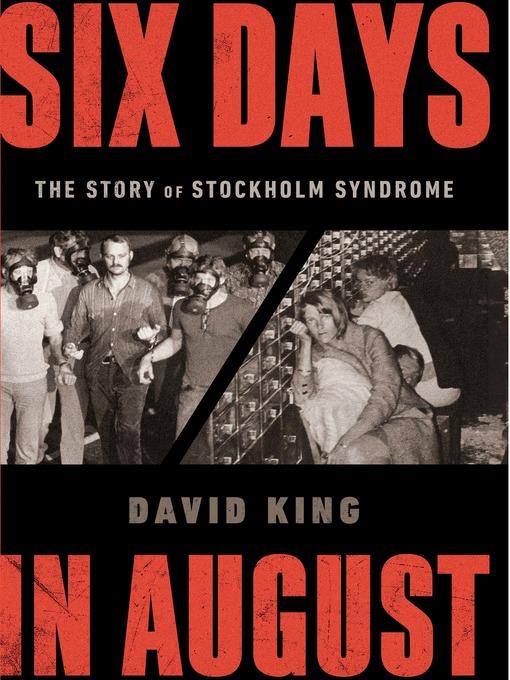
Six Days in August
The Story of Stockholm Syndrome
کتاب های مرتبط
- اطلاعات
- نقد و بررسی
- دیدگاه کاربران
نقد و بررسی

May 15, 2020
A historian painstakingly reconstructs the crime that gave rise to the pop-psychological term Stockholm syndrome. In August 1973, a furloughed Swedish convict armed with a submachine gun burst into a Stockholm bank and took four hostages, who, during their ordeal, seemed to grow attached to the gunman and a prison mate brought in at his request. The crime inspired the catchphrase Stockholm syndrome, which King defines as "the psychological tendency of a hostage to bond with, identify with, or sympathize with his or her captor." It is often applied to high-profile kidnapping victims such as Patty Hearst and Elizabeth Smart. The "syndrome," however, has been little studied and isn't an officially recognized psychiatric condition; rather, it is "more a media phenomenon than a proper psychiatric diagnosis." As such, King reconstructs the six-day standoff by drawing largely on sources other than academic studies, ranging from FBI materials to interviews with hostages and with gunman Jan-Erik "Janne" Olsson and his prison friend Clark Olofsson. In a suspenseful, chronological narrative, the author shows how missteps by the police, the media, and Prime Minister Olof Palme, combined with small acts of kindness by the hostage-takers, drew the group together. Early on, for example, the police barricaded the entrance to the bank vault in which the captors and captives hid, leaving the group with nothing to eat or drink, which made the hostage-takers look like heroes when authorities yielded to their demands for food. The most startling sign of a bond arose after the standoff ended when hostage Kristin Enmark asked captor Olofsson to father her child and was "devastated" when the resulting pregnancy was ectopic. King keeps a tight focus on ties that arise in hostage crises, but readers may suspect that some of his findings apply to the "terror bonding" that results from other crimes, such as domestic violence or child abuse. A true-crime page-turner about one of the more notorious bank heists of the past half century. (8 page b/w photos)
COPYRIGHT(2020) Kirkus Reviews, ALL RIGHTS RESERVED.

May 25, 2020
Historian King (The Trial of Adolf Hitler) delivers an entertaining, minute-by-minute account of the 1973 Swedish bank robbery and hostage crisis that gave rise to the term “Stockholm syndrome.” Opening with the moment gunman Jan-Erik Olsson entered Sveriges Kreditbank, King chronicles the taking of four bank workers as hostages; the arrival of Olsson’s former cellmate, Clark Olofsson (whose release Olsson had demanded, along with cash and free passage), at the bank; police efforts to bring the stalemate to an end; and the dramatic, tear gas–driven finale. Drawing on newspaper accounts and interviews, King brings readers into the stifling bank vault where Olsson and Olofsson hunker with their captives, documents debates among police and politicians over how to handle the crisis, follows journalists as they report on the story, and notes that one of the hostages had a brief affair with Olofsson after the ordeal was over. In a thorough analysis of the syndrome itself (defined by psychiatrist Nils Bejerot as “a paradox of common interest between hostage-taker and his victims”), King notes that the phenomenon’s wide acceptance in law enforcement and psychology circles, as well its permanent place in popular culture, belie its relatively rarity in hostage cases. True crime fans will love this engrossing and exhaustive account.

June 1, 2020
In 1973, in Stockholm, Sweden, convicted criminal Jan-Erik Olsson disappeared while on furlough, robbed a bank, and took hostages, who ended up identifying with Olsson and even defending him even as police attempted to rescue them. Their unusual behavior resulted in the term Stockholm syndrome, or hostages' tendencies to bond with their captors. King (The Trial of Adolf Hitler) offers a blow-by-blow account of this thrilling, terrible, and strange event, describing the setting and main figures, from the Kreditbanken that Olsson robbed to the hostages, law enforcement personnel, and Olsson and the other perpetrators who assisted him. The narrative is taut, detailed, and reminiscent of a documentary. A minor criticism: King spends a disproportionate amount of time chronicling the events and the individuals involved rather than exploring Stockholm syndrome, as the book's subtitle seems to suggest. Regardless, readers will feel the tension as they stand outside with police and journalists, as they are drawn into the bank vault along with the hostages, and as they witness the confusing resolution that followed. VERDICT Engrossing, well researched, and tailor-made for true crime enthusiasts.--Philip Shackelford, South Arkansas Community Coll., El Dorado
Copyright 2020 Library Journal, LLC Used with permission.

























دیدگاه کاربران